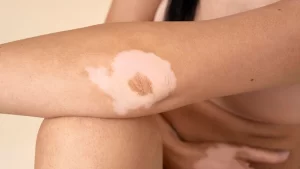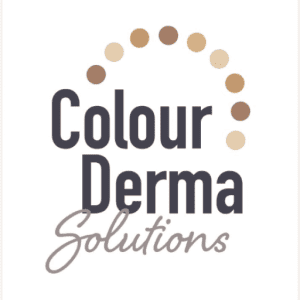Introduction
What to do after being diagnosed with vitiligo? – Vitiligo is a skin condition characterized by the loss of pigment, resulting in white patches that can appear anywhere on the body. This condition affects approximately 1% of the global population, making it a relatively common skin disorder. People of all ages, genders, and ethnicities can develop vitiligo, but it is often more noticeable in individuals with darker skin tones.
There are several misconceptions about vitiligo that can lead to confusion and misinformation when Understanding Vitiligo. One of the most common myths is that vitiligo is contagious, which is not true. Vitiligo is an autoimmune disorder, meaning it is caused by the body’s immune system attacking its own pigment-producing cells (melanocytes). Another misconception is that vitiligo only affects the skin’s appearance; however, the condition can have a significant  emotional impact on those living with it.
emotional impact on those living with it.
The emotional toll of vitiligo can be considerable, as it often affects an individual’s self-esteem and confidence. Many people with vitiligo feel self-conscious about their appearance, which can lead to social isolation, depression, or anxiety. It is essential to acknowledge and address the emotional aspects of vitiligo to help individuals cope with the condition and improve their overall quality of life.
Understanding Vitiligo
To better manage and treat vitiligo, it is crucial to understand its causes, types, symptoms, and diagnosis.
Causes of Vitiligo:
When Understanding Vitiligo its hard to pin point the exact cause, as this is still not entirely understood, but it is widely believed to be an autoimmune disorder. In individuals with vitiligo, the immune system mistakenly attacks melanocytes, the pigment-producing cells responsible for skin color. Genetic factors, oxidative stress, and environmental triggers may also play a role in the development of the condition.
Types of Vitiligo:
There are two primary types of vitiligo: segmental and non-segmental.
- Segmental vitiligo: This type is characterized by white patches that develop on one side of the body or in a limited area. It often begins at a younger age and progresses more quickly than non-segmental vitiligo.
- Non-segmental vitiligo: This type, also known as generalized vitiligo, is more common and results in symmetrical white patches on various parts of the body. Non-segmental vitiligo often progresses slowly and may stop or restart periodically.
Symptoms and Signs of Vitiligo:
The most apparent sign of vitiligo is the appearance of white patches on the skin. These patches can develop on any part of the body, including the face, hands, legs, and genital areas. The hair within the affected areas may also turn white or grey. Vitiligo does not typically cause physical discomfort, but the affected skin may be more sensitive to sunlight.
Diagnosis of Vitiligo:
A dermatologist can diagnose vitiligo through a physical examination and by taking a patient’s medical history. In some cases, the doctor may perform a skin biopsy or use a Wood’s lamp, a special ultraviolet light, to examine the skin more closely. Blood tests may also be ordered to rule out other autoimmune disorders.
Stages of Vitiligo:
Vitiligo progresses in stages, which vary from person to person. The initial stage is characterized by the appearance of small, white patches on the skin. As the condition progresses, these patches may enlarge, change shape, or merge with nearby patches. In some cases, vitiligo may stabilize, and no new patches will appear. However, the condition is unpredictable, and the progression and severity of vitiligo can differ significantly between individuals.

What to do after being diagnosed with vitiligo? Coping with a Vitiligo Diagnosis
Understanding Vitiligo can often mean coming to terms with a vitiligo diagnosis can be challenging, but with the right support and resources, individuals can learn to manage the condition and maintain a positive outlook on life.
It’s common for individuals diagnosed with vitiligo to experience a range of emotions, including shock, disbelief, fear, and sadness, not to mention stress. Recognizing these emotions is the first step towards accepting and coping with the diagnosis. It’s important to give oneself time to process these feelings and seek support from friends, family, or mental health professionals.
Connecting with others who have vitiligo can provide valuable emotional support, understanding, and practical advice. Support groups, whether in-person or online, offer a safe space to share experiences and coping strategies. Additionally, individual therapy with a mental health professional can help address specific concerns, such as anxiety or depression related to the condition.
The support of loved ones is crucial in helping individuals with vitiligo manage their condition. Family and friends should be understanding, empathetic, and willing to learn more about vitiligo. By offering emotional support and encouragement, loved ones can help build a strong foundation for coping with the challenges that vitiligo may present.
Working with a knowledgeable dermatologist is essential for managing vitiligo effectively. A dermatologist can help determine the most appropriate treatment options based on the type and severity of the condition. Treatment options may include topical medications, light therapy, or even surgical procedures in some cases. It’s crucial to discuss the benefits and risks of each treatment option with the dermatologist to make informed decisions about care.
Can Vitiligo be stopped from Spreading?
While some treatments may help slow the progression of vitiligo or restore pigment to the affected areas, it’s important to set realistic expectations about the outcomes. Each individual’s response to treatment will vary, and there is no guarantee that treatments will provide complete repigmentation or prevent future pigment loss. Understanding Vitiligo often means focusing on overall well-being, self-acceptance, and learning to live with vitiligo can help individuals maintain a positive mindset and improve their quality of life.
- Before
- After
Treatment Options for Understanding Vitiligo
Various treatment options are available for individuals with vitiligo, ranging from topical medications to surgical interventions. Each treatment aims to address the condition’s symptoms and improve the patient’s quality of life.
Topical medications for vitiligo are often the first line of treatment, and they can help restore pigment in some cases. Corticosteroid creams or ointments, calcineurin inhibitors, and topical psoralen plus ultraviolet A (PUVA) therapy are among the most common options. However, these medications may have side effects and should be used under a dermatologist’s supervision.
Phototherapy, also known as light therapy, is another widely used treatment for vitiligo. Narrowband ultraviolet B (NB-UVB) light therapy is considered the gold standard in vitiligo treatment, as it can stimulate pigment-producing cells and promote repigmentation. This treatment is usually administered two to three times a week over several months under the guidance of a dermatologist.
Excimer laser therapy is another form of light treatment that targets specific areas of the skin affected by vitiligo. This therapy uses a controlled beam of ultraviolet light to stimulate melanocyte growth and may be particularly effective for small, localized patches of vitiligo.
Surgical treatments for vitiligo are typically reserved for cases that do not respond to more conservative treatments. These procedures may include skin grafting, melanocyte transplantation, or tattooing. While surgical interventions can provide long-lasting results, they also carry risks and may not be suitable for everyone.
For individuals seeking a less invasive approach, camouflaging vitiligo with makeup or self-tanners can provide temporary relief from the visible symptoms of the condition. These cosmetic options can help improve self-esteem and confidence by concealing white patches and creating a more even skin tone. Various products are specifically designed to cover vitiligo and can be used daily or for special occasions.
It’s crucial to consult with a dermatologist to determine the most appropriate treatment option based on the type, severity, and location of vitiligo, as well as personal preferences and overall health.

Understanding Vitiligo – Living with Vitiligo
Adjusting to life and Understanding Vitiligo, involves making lifestyle changes to protect and care for your skin, as well as finding ways to embrace the condition as part of your unique identity. The following tips can help make living with vitiligo more manageable and fulfilling.
Skin Care Routines for People with Vitiligo:
Maintaining a consistent skin care routine can help keep skin with vitiligo healthy and hydrated. Use gentle, fragrance-free cleansers and moisturizers to avoid irritating the skin. Avoid using harsh scrubs or exfoliants, as they may cause inflammation in sensitive areas. Consult with a dermatologist for personalized recommendations on skin care products and routines.
Lifestyle Adjustments for People with Vitiligo:
Understanding Vitiligo will often mean making lifestyle adjustments can help improve overall well-being and reduce the impact of vitiligo on daily life. Managing stress through practices like meditation, yoga, or deep breathing can help minimize potential triggers for vitiligo flare-ups. Eating a balanced diet and getting regular exercise can also contribute to overall skin health and well-being.
Integrating Vitiligo into Your Personal Style:
Instead of trying to hide vitiligo, some individuals choose to embrace it as part of their unique appearance. This can involve incorporating clothing, accessories, or makeup that highlight the contrast between pigmented and non-pigmented skin. Celebrating vitiligo as a distinctive aspect of your personal style can help foster self-acceptance and confidence.
Addressing Social Stigma
Despite growing awareness about vitiligo, the condition still carries a social stigma that can affect the lives of those who have it. To foster a more inclusive and understanding society, efforts must be made to combat negative stereotypes, address discrimination and prejudice, and share personal experiences to promote acceptance.
Advocacy and awareness efforts for vitiligo play a crucial role in breaking down misconceptions about the condition. Participating in or supporting local, national, or international organizations dedicated to vitiligo can help raise awareness and promote understanding. These organizations often organize events, campaigns, or educational materials to highlight the experiences of people living with vitiligo and encourage empathy from others.
Combating negative stereotypes involves challenging the myths and misunderstandings that surround vitiligo. This can include dispelling false notions that vitiligo is contagious or a result of poor hygiene. By educating others about the autoimmune nature of vitiligo and the reality of living with the condition, we can create a more accurate and compassionate perception of those affected by it.
Addressing discrimination and prejudice requires acknowledging and confronting instances where people with vitiligo are treated unfairly due to their appearance. This may involve advocating for anti-discrimination policies in schools or workplaces, or speaking up when witnessing bias against someone with vitiligo. Encouraging inclusivity and respect for all, regardless of their skin condition, is essential to building a more equitable society.
Sharing personal experiences with vitiligo can help promote understanding and acceptance among those who may not be familiar with the condition. By discussing the challenges, victories, and day-to-day realities of living with vitiligo, individuals can foster empathy and humanize the condition. Opening up about one’s journey with vitiligo can also inspire others to share their stories, creating a sense of community and solidarity among those affected by the condition.
Addressing the social stigma surrounding vitiligo requires a collective effort to educate, advocate, and support those living with the condition. By working together, we can create a more inclusive and understanding society where people with vitiligo are accepted and celebrated for their uniqueness.

Conclusion – Diagnosed with vitiligo What to do next?
In conclusion, vitiligo is a complex skin condition that can have significant emotional and social implications for those affected by it. Throughout this article, we have explored various aspects of coping with a vitiligo diagnosis, from understanding the condition’s causes and symptoms to seeking support, embracing self-acceptance, and implementing effective self-care strategies.
It is crucial for individuals with vitiligo to seek help and support from loved ones, medical professionals, and support groups. This network of support can provide valuable information, understanding, and encouragement to help manage the condition and maintain a positive outlook.
Self-care and self-acceptance are of paramount importance when living with vitiligo. By taking care of one’s physical and emotional well-being, individuals can foster self-confidence and embrace their unique appearance, making the journey with vitiligo a more manageable and fulfilling experience.

At Colourderma, we understand the challenges that individuals with vitiligo face and are committed to helping them feel confident and comfortable in their skin. Our range of high-quality camouflage makeup products has been specially designed to help those with vitiligo achieve an even, natural-looking skin tone. With Colourderma, you can regain control of your appearance and embrace your uniqueness with confidence. To learn more about our products and how they can enhance your daily life, please visit our website at www.colourderma.com.
Remember, living with vitiligo is a journey, and with the right support, resources, and self-care, you can thrive while embracing your unique identity.

FAQs
Q: Is vitiligo contagious?
A: No, vitiligo is not contagious. It is an autoimmune disorder in which the body’s immune system mistakenly attacks melanocytes, the pigment-producing cells in the skin. This results in the loss of pigmentation in patches on the skin. Vitiligo cannot be spread through contact or any other means.
Q: What are the treatment options for vitiligo?
A: Treatment options for vitiligo include topical medications (such as corticosteroid creams or calcineurin inhibitors), phototherapy (light therapy), excimer laser therapy, surgical treatments (like skin grafting or melanocyte transplantation), and camouflaging with makeup or self-tanners. The most appropriate treatment depends on the individual’s specific case and should be determined in consultation with a dermatologist.
Q: How can I protect my skin from the sun when I have vitiligo?
A: Protecting your skin from the sun is essential when living with vitiligo. Use a broad-spectrum sunscreen with an SPF of 30 or higher on all exposed skin, including areas affected by vitiligo. Wear protective clothing, such as wide-brimmed hats, sunglasses, and long sleeves, and seek shade when outdoors. Reapply sunscreen every two hours or more frequently if swimming or sweating.

Q: Can vitiligo be cured?
A: While there is no known cure for vitiligo, there are various treatment options available that may help restore pigmentation to affected areas, slow the progression of the condition, or improve the appearance of the skin. The effectiveness of these treatments varies from person to person, and it’s important to consult with a dermatologist to determine the most suitable approach for each individual case.
Q: Will my vitiligo get worse over time?
A: The progression of vitiligo is unpredictable and varies from person to person. In some cases, the condition may remain stable or even improve, while in others, it may worsen over time. Factors such as stress, sun exposure, and skin injuries can potentially trigger the spread of vitiligo. Working with a dermatologist to manage the condition and maintain a healthy lifestyle can help minimize the risk of vitiligo progressing.





Recent Comments